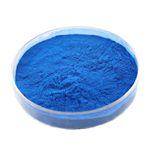| Company Name: |
Zhejiang Binmei Biotechnology Co., Ltd Gold
|
| Tel: |
0576-89395153 13732316985 |
| Email: |
jenkin@chinabinmei.com |
| Products Intro: |
Product Name:Phycocyanin E25
Purity:Amax/A280 ≥ 2.5 Package:≥1Kg/RMB 1800;≥100Kg/RMB 1600
|
- Phycocyanin
-

- $120.00 / 1KG
-
2023-11-30
- CAS:
- Min. Order: 1KG
- Purity: E18,USP Standard
- Supply Ability: 800KGs
|
| | PHYCOCYANIN Basic information |
| | PHYCOCYANIN Chemical Properties |
| | PHYCOCYANIN Usage And Synthesis |
| Description | Phycocyanin is a blue dye formed by cyanobacteria, cryptophytes, and rhodophytes.
It is an interesting nutraceutical because of its suspected antioxidative
properties, and it is also applied for coloring and fluorescence in biochemical
assays. Despite these interesting properties, the yearly market value is comparatively
low. Currently, phycocyanin is produced in open basin cultures containing
the cyanobacterium Arthrospira (Spirulina) platensis. However, productivities are
low as the cultures are very sensitive to contaminating organisms. Recent studies
addressing chemical modifications have enhanced the potential applications of
phycocyanin in the fields of diagnostics and applications in food, nutraceuticals,
and biotechnology. Furthermore, optimization programs significantly
increased productivity in heterotrophic and acidophilic cultures of the red alga
Galdieria sulphuraria which are grown under well-controlled and axenic conditions. This makes G. sulphuraria an attractive alternative for Spirulina.
Furthermore, improvement was achieved with regard to downstream processing:
the application of two-phase aqueous extraction methods and optimized purification
technologies have resulted in higher productivity and improved performance.
Table 4 summarizes the main producers of natural b-carotene, astaxanthin, lutein,
and phycoerythrin. | | Biotechnological Production | In 2008, the presence of a-, b-, c-, d-, and e-carotenes was reported in 76 algae, 5
fungi, and 4 bacteria. Among them, b-carotene is produced by a number of
fungi, for example, by Phycomyces, Mucor, and B. trispora, and dry matter
contents of 4–5 g /l are achieved.
Blakeslea trispora is a fungal plant pathogen and belongs to the order of
Mucorales. The fungus is nonpathogenic and nontoxigenic for humans and animals.
This order includes Phycomyces blakesleeanus, Choanephora cucurbitarum,
and B. trispora. Two opposite mating types, namely (+) "plus" and (-) "minus"
exist of the Phycomycete B. trispora, and both are able to form zygospores. When
plus and minus mating types are cultivated on the same mating plate, they form
progametangia. Then septation takes place in the progametangia, which results in
the formation of gametangia, which fuse to form zygospores. On these spots high
levels of b-carotene are formed [188]. When these types are separated, both types
produce low levels of carotenoids, albeit the (-) mating type produces slightly
more. However, when the two types are cultivated together in a specific ratio, the
(-) type starts to produce 10–20 times more b-carotene and lycopene. The reason
is that the (+) type produces the sex hormone trisporic acid, which serves as a
stimulator of carotenogenesis. The common denominator of the stimulating
effect of trisporic acids are the ionone ring and the hydrocarbon side chain. |
| | PHYCOCYANIN Preparation Products And Raw materials |
|